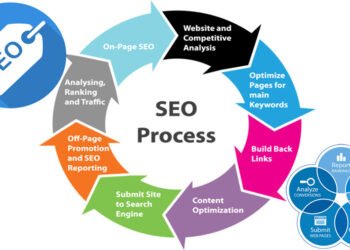The term SEO, or search engine optimization, covers a wide range of topics than just the written content on your website. These elements consist of the website’s reaction time, aesthetics, design, and image optimization. Many website owners are unaware of the multiple ways that images and aesthetics affect SEO. As a result, it’s critical to pay attention to factors like the size, type, load time, and alt-text of a picture on a website.
It is uncommon for Google, which accounts for roughly 98% of the market for search engines overall, to produce results without a pictures tab. In fact, images are returned in response to about 28% of all inquiries. Approximately 23 percent of all searches are for Google images. Furthermore, 63% of people who engage with a picture that Google presents in answer to their query also go to the image’s source website. What’s even more intriguing is that updating an existing blog post’s image with a new one and publishing it again can boost organic traffic by an astounding 106%.
In order to better understand the impact of high-quality, relevant images on SEO, here is a case study:
Impact Of Relevant Images On SEO – A Case Study
It is common knowledge now that using either original or high-quality stock photos influences search engine result rankings, but its extent has been explored with an experiment recently. The test was applied to a blog post that detailed a common lawn care problem that residents of a particular area were facing. The page had decent views even though the picture used was small and blurred.
In a bid to update that, a high-quality image of a skunk was used since these animals, along with raccoons, were the root cause of the problem listed in the article. However, the image actually had an adverse impact, causing the page ranking to drop from the 2nd to 3rd position in the Google search results within just a couple of weeks.
After an analysis, it was found that Google didn’t find the picture of a skunk relevant to the content of the article. Typing the relevant keywords of the article in Google Images specifically, i.e., common lawn care problems, it showed pictures of dirt holes dug up and not skunks.
Subsequently, the image of the animal was replaced with a high-quality one that depicted exactly what Google desired. The result was outstanding. Not only did the result rise to the top of the ranking page, it also became the featured snippet. Moreover, the new image that was recently added became the featured one in the snippet as well.
This experiment clearly depicts the effect that just the image can have on the ranking of a result. With that in mind, here are some image SEO tips that can help:
Make Sure You Select The Format Carefully
Making sure you are using the appropriate format for the greatest outcomes is the next step in guaranteeing proper image SEO. The file format you select for your photos has a huge impact on how quickly your website loads, which is important for SEO reasons, as we’ve already covered. GIF, PNG, and JPEG are the three most widely used image formats. Although each file has advantages and disadvantages, JPEG and PNG are preferable in terms of website SEO.
JPEG is excellent for photos, PNG is perfect for transparent images, and GIF is appropriate for animations. Select the configuration that best fits the sort of picture you’re using to improve how quickly your website loads. For instance, the only image format that both Firefox and Chrome support is the WebP format with lossless or lossy compression. Additionally, think about employing techniques to further reduce the size of your photographs without sacrificing quality. Faster load times due to smaller image sizes will improve your SEO rankings.
Optimize The Image By Compressing It
After selecting the appropriate format for the photographs on your website, you work with the appropriate sizes. According to some of the most recent research, photos can account for up to 21% of a website’s overall size. Large picture files can cause your website to load slowly, which will disrupt users’ experiences and your SEO position.
To minimize file sizes while keeping image quality, use image compression software programs, a lot of which are commonly available online. With the help of these programs, the image file can be reduced in size without suffering from apparent quality loss. For context, a number of experiments conducted by third-party researchers have demonstrated that visual compression can increase website load times by over 10%.
Create A Unique Image That Resonates With The Audience
After spending an ample amount of time discussing website efficiency and load times, let’s concentrate on another aspect of image SEO that can affect your site’s rating: User retention, specifically through content with value. A user will never remain engaged in a similar, outdated, monotonous design with clichéd content for very long. Additionally, if a large number of people are quickly abandoning your website, Google will deem the site unreliable and will consequently rank it much lower.
Images do not just contribute to user retention, but they also contribute significantly to SEO. Therefore, it is best to think about making unique images that complement the identity and messaging of your company. Original photographs not only help your material stand out from the crowd but also avoid duplicate content problems that could harm your SEO. If you can’t make your own graphics, search for less-commonly used royalty-free photos to give your content a little extra flair.
The File Name Impacts SEO As Well
The name you give your image files is another element that might have an impact on image SEO. In order to avoid utilizing conventional names for files like “image02.jpg,” be creative and use pertinent keywords. Consider renaming your image “beautiful-vacation-resort.jpg” if it is about a resort with a scenic view. This practice increases the likelihood of ranking better in searches by making it simpler for Google to interpret the information in your photographs. Use hyphens rather than underscore or spaces for separating terms in file names since Google understands them better.
Conclusion
Many companies and websites believe that SEO consists exclusively of improving the textual content that appears on their websites. This is no longer the case, though, as a result of changes made to Google’s algorithms. The capacity to search via photographs is actually something that 62% of Millennial and Gen-Z consumers want more than anything else that is just starting to take off in the market, which is interesting to know. It also shows the importance of high-quality images in SEO. Therefore, you must put extra effort into using the right image to enhance your content and its ranking on search engine result pages.












